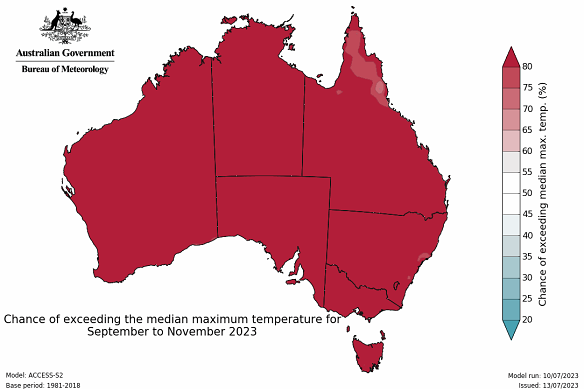The hottest July in 120,000 years. What’s in store for Australia this summer?
By Nick O'Malley and Angus Dalton
This month is likely to be the hottest July the earth has experienced in about 120,000 years after a series of lingering heatwaves seared the northern hemisphere, says one of the world’s leading climate scientists, Professor Michael Mann.
The unprecedented extreme weather emergencies provide a glimpse into Australia’s near future and suggest the impacts of global warming might have been underestimated, he told this masthead.

Globally renowned climatologist Michael Mann at the National Climate Emergency Summit in Melbourne in February 2020.Credit: Julian Meehan
Records have been shattered across the world, from China to Siberia, across Europe, the Middle East and North America due to a string of slow-moving heatwaves that have been exacerbated by the re-emergence of an El Niño weather pattern.
In Rome on Tuesday, the temperature record was shattered by more than a full degree when the mercury hit 41.8 degrees, and a new record of 52.2 degrees was set in a remote township in China’s western Xinjiang region. In Phoenix, Arizona, in the United States south-west, temperatures topped 40 degrees for a record 19 consecutive days.
In Iran, at the Persian Gulf International Airport, a heat index – a measure that combines temperature and humidity to reflect the heat impact on a person – of 66.7 degrees was recorded.
Mann, of the University of Pennsylvania, said the extreme temperatures suggested models predicting the increase in the earth’s average temperature as a result of carbon dioxide emissions had been proved correct.
“The surface warming is almost precisely what was predicted by the models,” he said.
“That’s bad enough. But some of the impacts are exceeding what was predicted – extreme weather events including heatwaves, droughts, wildfires – something Australia has seen plenty of, and floods, something else that Australia has seen plenty of in recent years.”
This was because predicting the average global temperature increase is a comparatively simple task compared with predicting the impact of the heat on weather patterns.
Climate models also tend to underestimate the frequency and duration of “blocking highs”, the high-pressure systems that have settled over large parts of the northern hemisphere and summoned record heat.
These so-called heat domes may have been caused, in part, by the slowing of the jet stream – high altitude winds that normally circle the globe below the Arctic Circle. The stream’s stagnation was most likely caused by climate change.
A slower jet stream becomes “wiggly”, Bureau of Meteorology climatologist Hugh McDowell said, which creates more curves in the stream. As winds come into a curve, they decelerate, which can cause air to pile up into high-pressure systems and make “anticyclones” more likely.
Anticyclones are circulations of wind that can keep the areas they form over stubbornly hot and clear of clouds. They’re less famous than their stormy cousins, but anticyclones have adopted the tradition of being named as they inflict scorching heat across Europe; first there was Cerberus (named for the hound of Hades) and now Charon (the Greek underworld’s ferryman of the dead).
When anticyclones form over Australia’s interior, heat can build up and sweep eastward, said Professor Steven Sherwood, an atmospheric scientist at the UNSW Climate Change Research Centre.
“Here in Sydney or Melbourne, it’s when we get heat from the interior of the country blasting over here that we tend to get our maximum [temperatures],” he said. “It’s a similar process to what’s happening in the north. The difference is that the long-term warming trend has been less, so far, in the southern hemisphere.”
The northern hemisphere is warming faster because it has twice the land mass of the southern hemisphere, which is 80 per cent ocean. But looking north is like peering into our near-future, Sherwood said.
“It’s a little like On the Beach. We tend to be a little protected down here by having less land mass, but the warming will eventually happen here too.”
Sherwood has said we’ve added the equivalent energy of 25 billion nuclear bombs to earth’s atmosphere and oceans in the past 50 years through burning fossil fuels. Most of the heat generated is absorbed by the oceans, which are now at record temperatures and are no longer able to cool the atmosphere as much as they once did.
Identifying a direct knock-on effect of the extreme heat in the northern hemisphere for Australia is difficult. The return of the El Niño weather pattern, which typically warms the planet by 0.2 degrees, will be the biggest factor in spring and summer heat in Australia.
But the bureau has said there’s an 80 per cent chance of above-average temperatures between August and October across most of Australia, based on models that draw on subsurface ocean heat and data from satellites and weather balloons across the globe, including from the superheated north.
“There will be some sort of impact globally from those high temperatures across the northern hemisphere because it’s a closed system, right?” McDowell said. “The earth is all enclosed in one atmosphere. There’s no in and there’s no out.”

The vast majority of Australia has an 80 per cent chance of reaching above-average temperatures in spring. Credit: Bureau of Meteorology
The UN’s World Meteorological Organisation warned this week that heatwaves are the most lethal of all extreme weather events, saying it estimated 60,000 people died as result last year.
“Repeated high night-time temperatures are particularly dangerous for human health because the body is unable to recover from sustained heat,” said the WMO’s senior heat adviser, John Nairn. “This leads to increased cases of heart attacks and death.”
United Nations Secretary General Antonio Guterres said in a speech on Tuesday that “half of humanity is in the danger zone” from extreme weather events.
“This has to be the decade of decisive climate action … We have a choice – collective action or collective suicide.”
The impact of the coming summer’s heat on Australia is likely to be profound, said Mann.
“I do know Australia well. I consider it a second home. The growing El Niño likely means worse drought, bushfires, and heatwaves for Australia in the coming year and yes, that’s in addition to the exacerbating effects of continued planetary warming.
“Human civilisation and infrastructure is resilient to a point, but there’s a threshold – a ‘tipping point’ if you like – where we exceed our limit of resilience.
“The combination of an El Niño and continued warming has the potential to push Australia beyond that point. It’s something we all sensed – myself included since I was there – during the Black Summer [bushfires]. And the summers will only get blacker and blacker if we continue to burn fossil fuels.”
Get to the heart of what’s happening with climate change and the environment. Our fortnightly Environment newsletter brings you the news, the issues and the solutions. Sign up here.